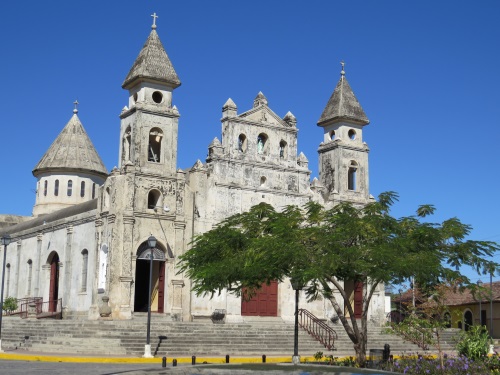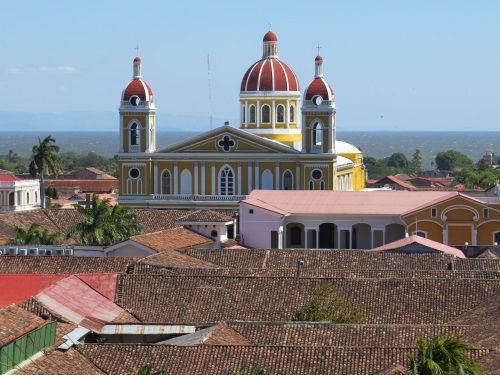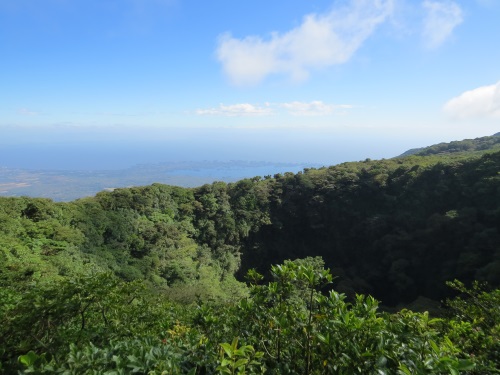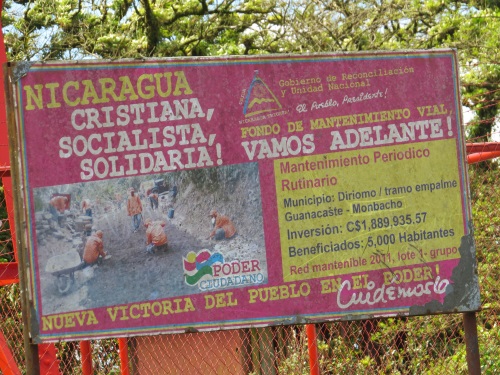Blog TWHS Visits
Granada and its natural environment
 |
 |
 |
Els - 20 February 2015
Comments
Els Slots 21 February 2015
Regarding the trans-isthmian "Nicaragua Canal": no I did not notice any activity pro or contra this adventure. It might be considered "Progress", certainly by the ruling Sandinist party but probably also by the general public. What I did notice were the many signs like the one below: we're building / revamping our country! (and oh, we're Christians too)
 |
Solivagant 21 February 2015
PS. I have just been revisiting my photos of Granada and came across those of the Precolombian Statues in the San Francsico Museum and taken from Zapatera. My photos of the descriptions of each exhibit (always worth having in these digital days!) describe how the site was discovered by Ephraim George Squier in 1849. Now as an "informal" WHS "Connection" - one of the palace complexes at Chan-Chan is named after this same guy! He is considered one of the pioneers of Pre-columbian archaeology and his book "Ancient monuments of the Mississippi Valley" was the first study of the North American Mound Builders and their sites. The general assessment of the sites on Zapatera Island however seems to be that most remains of significance are in musea (as in Granada) and what is still in situ is badly degraded so, although pre-columbian sites south of the Maya are not well represented on the list (Joya de Ceren and the Spheres of the Diquis) it wouldn't appear that this site would score highly on that aspect either
Solivagant 20 February 2015
Els, whilst you were in Nicaragua did you manage to explore the reality of the proposed trans-isthmian canal? "Construction" was supposed to have started in Dec 2014 (for completion around 2020?)and the route chosen misses Granada, going, on the East, from approximately the middle of the Lake on a slightly SW route, south of Omotepe to a little town called Brito whence by canal to the Pacific.
But the effects on the ecology of the lake (which is already polluted - it has been nicknamed "The world's biggest toilet"!) could well be serious. Certainly one can't see ecologists etc being very pleased -and, through them UNESCO etc!
I understand that despite the recent start on construction there is still significant opposition to the canal in Nicaragua, mainly for economic reasons - can it really compete withe an enlarged Panama Canal given the wealth of Panama? But Ortega rules the roost for now and international politics also plays a part with China and Russia "fishing" in the waters. The supposed start on construction just a few days beofre the end of 2014 seems highly suspicious.
In so far as any possible Granada nomination includes natural aspects, I would have thought it was dead in the water with the canal being built! Furthermore, when we were in Granada, we were given a free tour of the "365 Islands" by the company we had booked our San Juan River area trip with. We found these islands to have have been heavily developed as holiday homes by wealthy Nicaraguans and their ownership mired in the vicissitudes of Nicaraguan politics over the last 30 years. Whilst there were a few monkeys on monkey island and some old fort structures the Archipelago didn't seem to have a lot to commend it other than as an afternoon trip for tourists ex Granada and as a chill out location for cabins etc.
Way down at the San Juan river (SE corner of the lake) there is another set of Islands - the Solentiname - but IMO the glory of the area is the San Juan river itself, the natural corridor of Indio Maiz which crosses it and the Fortress of the Immaculate Conception situated half way along it. But that too seems to have waxed and waned as a possible nomination and all the indications I have been able to discover are that the possibility is disappearing